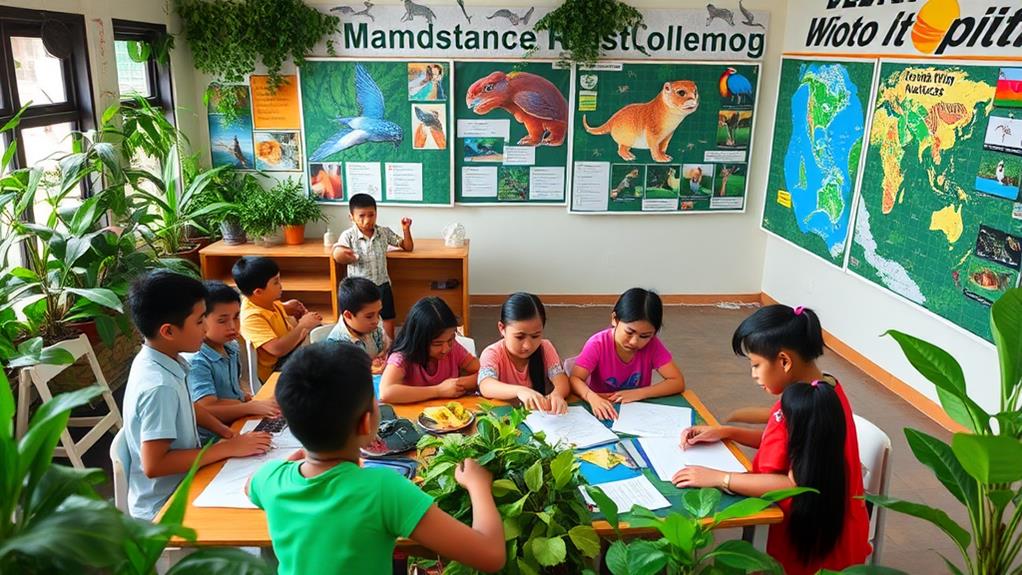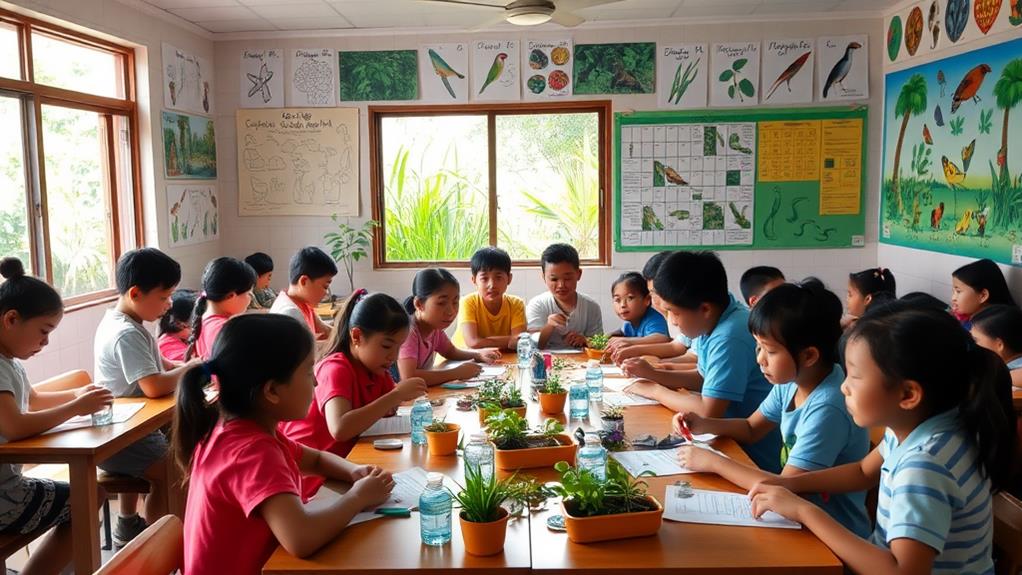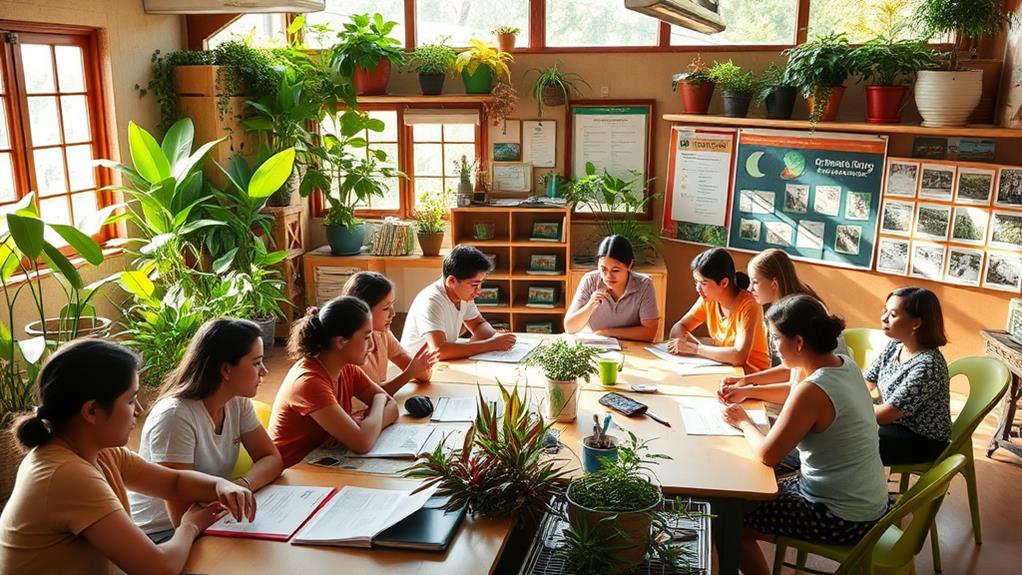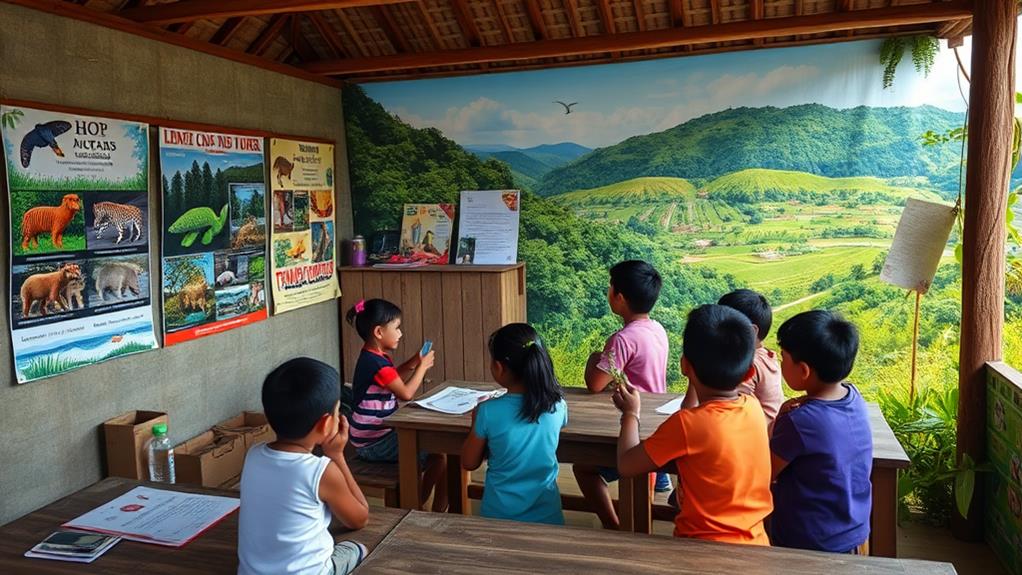Education and awareness are essential for natural resource conservation in the Philippines. Students learn about sustainability when environmental education is included in school curriculums. The government supports this by requiring schools to teach about the environment and encouraging community involvement.
For example, students can participate in tree planting and clean-up drives, which help them engage with their local environment.
Teachers receive special training to help them teach these important topics effectively. This training ensures they can explain concepts like biodiversity and pollution clearly.
Additionally, universities contribute by conducting research and promoting sustainable practices in their communities. Overall, education is a powerful tool for protecting the Philippines' natural resources.
Importance of Education in Conservation

Education can transform our approach to conservation in the Philippines. It helps people understand and care about the environment. The National Environmental Awareness and Education Act ensures that schools teach about environmental issues. This is important for effective conservation efforts.
Programs like the National Search for Sustainable and Eco-Friendly Schools reward schools that focus on environmental education. This creates a culture of conservation among students and teachers.
Additionally, Republic Act No. 9512 requires training programs for teachers. This helps them gain the knowledge and skills needed to promote conservation practices effectively.
Higher education institutions are also making changes. They're adjusting their courses to include sustainable forest management. This helps raise awareness about conserving natural resources.
Research shows that people with higher education levels are more likely to engage in pro-environmental behaviors, which leads to better conservation results in their communities.
Government Policies Supporting Awareness
The government of the Philippines supports environmental awareness through specific policies. One important policy is the National Environmental Awareness and Education Act, which requires schools to teach students about conservation. This helps students understand why it's important to protect natural resources.
Another significant law is Republic Act No. 9512, which promotes public awareness of natural resource conservation. This act encourages various educational programs that focus on sustainable practices. Each November, the country celebrates National Environmental Awareness Month, which includes activities aimed at increasing people's understanding of environmental issues.
Here is a summary of these initiatives:
| Policy/Program | Focus Area |
|---|---|
| National Environmental Awareness and Education Act | Requires environmental education in schools |
| Republic Act No. 9512 | Encourages awareness of natural resource conservation |
| National Search for Sustainable and Eco-Friendly Schools | Recognizes schools with effective environmental education |
These policies involve cooperation among the Department of Education, Commission on Higher Education, and Technical Education and Skills Development Authority. Together, they improve environmental education and promote a culture of conservation. By implementing these policies, the government helps create a more environmentally conscious society.
Environmental Education in Schools

Environmental education has become an important part of the national curriculum in the Philippines. The National Environmental Awareness and Education Act requires students to learn about environmental issues, laws, and policies. This helps shape responsible future generations.
Programs like the National Search for Sustainable and Eco-Friendly Schools recognize schools that excel in environmental education. These schools inspire others to adopt sustainable practices. For instance, during November, which is National Environmental Awareness Month, schools participate in activities that promote sustainability. This creates a culture that values eco-consciousness.
Capacity-building programs under Republic Act No. 9512 provide educators with tools to teach environmental education effectively. These include training, workshops, and educational materials. For example, teachers learn how to engage students in discussions about local environmental issues.
Collaborations with organizations like ASEAN give students structured learning opportunities, allowing them to participate in solving local environmental challenges.
Together, these initiatives create a learning environment that promotes environmental stewardship. Students gain skills that help them contribute to conserving natural resources.
Community Engagement and Participation
Community engagement in the Philippines is essential for promoting environmental care.
Participating in programs like the National Search for Sustainable and Eco-Friendly Schools allows you to take an active role in environmental education. These initiatives help you and your neighbors feel responsible for protecting natural resources.
Engaging in tree planting and clean-up drives brings your community together to combat pollution and protect biodiversity. Working with local schools raises awareness about important environmental issues, encouraging everyone to practice sustainability.
Community-based management strategies give you a say in decisions about conserving natural resources. This is important because it ensures that local needs and values are considered in policies.
Training for educators improves their ability to teach about conservation. This education spreads awareness and encourages families to adopt pro-environmental behaviors.
Professional Development for Educators

Professional development for educators in the Philippines is essential for improving environmental education. You can enhance your knowledge of environmental issues through capacity-building programs outlined in Section 7 of Republic Act No. 9512.
The Department of Education, Commission on Higher Education, and Technical Education and Skills Development Authority collaborate to offer training workshops, seminars, and resources that provide the latest information on environmental conservation.
By engaging in continuous professional development, you can lead in integrating environmental education into your lessons. For example, institutions like UPLB CFNR provide specialized training focused on sustainable forest management and environmental stewardship, equipping you with the skills to teach these important topics effectively.
Your role as an educator is vital in creating a culture of environmental awareness. Participating in these professional development opportunities not only helps you grow but also inspires your students to adopt pro-environmental behaviors.
This commitment affects not just your classroom but also the wider community, promoting awareness and action for natural resource conservation across the Philippines.
Role of Higher Education Institutions
Higher education institutions in the Philippines play a vital role in promoting sustainable development and environmental conservation. They work closely with local communities to raise awareness about environmental issues and implement conservation initiatives to better manage natural resources. Universities also provide innovative training programs, which help educators and community leaders build a strong culture of sustainability.
Here are some specific ways these institutions contribute to environmental conservation:
| Contribution | Example |
|---|---|
| Joint Projects | They run environmental awareness campaigns in local communities. |
| Human Capital Development | They offer training programs focused on natural resource management. |
| Curriculum Integration | They include sustainable practices in forestry courses. |
| Pro-Environmental Behavior | Research shows that graduates are more likely to engage in conservation efforts. |
These actions illustrate how higher education institutions in the Philippines are essential to protecting the environment and promoting sustainability.
How Does Education and Awareness Contribute to Research and Development in Natural Resource Conservation in the Philippines?
Education and awareness play a crucial role in the importance of natural resources research in the Philippines. By empowering people with knowledge about sustainable practices, it fosters a culture of conservation and innovation. This contributes to research and development efforts aimed at preserving the country’s rich biodiversity and natural resources.
Challenges in Environmental Education

The National Environmental Awareness and Education Act aims to include environmental education in schools, but many schools face challenges in doing this effectively.
These challenges include inadequate resources and training for teachers, which affects the quality of lessons. For example, teachers may not have access to the latest information on environmental issues or the tools needed to teach effectively.
Another issue is the lack of standardized materials for environmental education. Without consistent resources, students may receive different information based on their school. For instance, one school might teach about recycling while another doesn't cover it at all.
High dropout rates also pose a problem, especially in rural areas where students might leave school due to economic pressures. This limits the number of children who receive environmental education.
Socioeconomic disparities create further barriers. Low-income students may not have the same access to information about environmental issues compared to their wealthier peers. This can result in a lack of awareness about crucial topics like climate change or conservation.
Lastly, rapid urbanization and industrialization often focus on immediate profit rather than long-term sustainability. For example, new factories may be built without considering their environmental impact, leading to pollution and habitat loss.
To improve environmental education in the Philippines, it's essential to address these challenges.
Investing in teacher training and developing standardized materials can enhance learning. Additionally, ensuring that all students have equal access to education can help create a more informed generation.
Future Directions for Conservation Efforts
The Philippines is focusing on improving environmental education to support conservation efforts. The goal is to create programs that teach people about sustainability and how to manage resources wisely.
For example, the National Search for Sustainable and Eco-Friendly Schools encourages schools to design creative lessons and involve students in local conservation activities. This hands-on approach makes learning more effective.
Partnerships between universities and local communities will increase. These collaborations will use research to solve environmental problems. This is important for addressing challenges like climate change and development.
Technology will also play a key role in education. Online training and awareness campaigns can reach more people and provide ongoing learning opportunities.
Advocating for better environmental policies is another focus. Stronger enforcement of environmental laws is necessary for progress.
Educated citizens who value nature will help drive these changes. By emphasizing education and awareness, the Philippines aims to build a future where conservation is embraced by everyone.
Questions and Answers
What Is the Environmental Awareness and Education in the Philippines?
Environmental awareness and education in the Philippines improve your understanding of ecological issues. Schools promote sustainable practices by teaching students about recycling and energy conservation. Community initiatives encourage people to work together to protect the environment, such as tree planting projects and clean-up drives. These activities help you learn about the importance of preserving nature for future generations. By participating in these efforts, you actively contribute to a healthier planet.
Why Might Education Be Important to Protecting Natural Resources?
Education is crucial for protecting natural resources. It helps people understand environmental issues. For example, when students learn about pollution, they can push for cleaner air and water in their communities. Knowledge leads to action. With education, individuals can advocate for recycling programs and conservation efforts, like planting trees. Informed citizens can influence policy. They can vote for leaders who prioritize sustainable practices, ensuring resources are used wisely. The more people know, the better they can protect the environment for future generations.
What Are the Ways of Conserving the Philippine Natural Resources?
You can conserve the Philippines' natural resources by adopting sustainable practices. One effective way is recycling, which helps reduce waste and keep materials out of landfills. For example, recycling plastic bottles can save energy and reduce pollution.
Another important action is participating in community activities such as tree planting. Planting trees helps improve air quality, provides habitats for wildlife, and combats climate change.
Engaging in clean-up drives is also crucial. These events help remove trash from local beaches and parks, protecting ecosystems and promoting a healthier environment.
What Is Education for Sustainable Development in the Philippines?
Education for Sustainable Development in the Philippines focuses on teaching practices that help the environment. Schools incorporate environmental education into their lessons. For example, students might learn about recycling, conservation, and the importance of biodiversity. This helps students understand how their actions affect the planet.
Community engagement also plays a crucial role. Schools often partner with local organizations to work on projects like tree planting and clean-up drives. Such activities encourage students to take action towards a sustainable future. By learning about these issues, students become more aware and active in their communities.